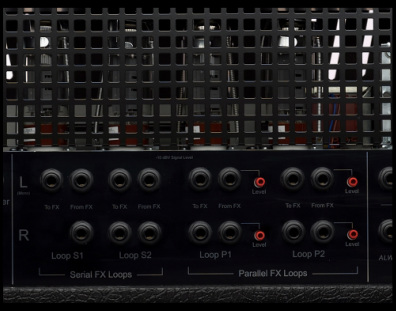 Effects Loops Explained by Dolf Koch Nowadays, an effects loop is an integral part of almost any musical amplifier. Although it just looks like it’s no more than just two jack inputs, a “Send” and a “Return”, there is so much more behind it! The History Tube amps made in the 50s and 60s have no effect loops simply because there were no effect units. The only two effects available were reverb and tremolo and top of the line models had one or both effects built in. Later, when effect units became available (wah-wah, delay, chorus, flanger), they were always connected between instrument and the amplifier input. Because amps didn’t have distortion channels this worked very well. However, when the first amps with overdrive channels came on the market, it turned out that having effect units in front of an overdrive channel increased the level of hissing noise rather drastically. Besides that, chorus type effects almost dissapeared and became inaudible when the distortion level was turned up high. In recording studios, mixing consoles had so called “Inserts” in each channel as well as in the master section. This is a stereo jack with a combined input and output which made it possible to insert an effects unit in the signal path (serial connection). If you wanted to have better control over your effects, the unit’s output could be fed back to a (free) channel input (parallel connection). In the 70s, these Inserts became a feature on guitar amps as well and got the name: “Effects Loop” or “FX Loop”. The output was called “Send” and the input “Return” and they are always placed between the preamp and the power amp section. This is the so called serial effects loop. It might seem simple to build an effects loop in an amp, just cut the wire that connects the preamp with the power amp and place two jack plugs instead. Yet nothing could be further from the truth, especially in tube amps. I’ll try to explain why. Problem 1: Tubes operate on very high voltages from 300-500V. Therefore, signal levels inside a tube amp are very high. Effect units, which are mostly battery operated, operate on 9V. Therefore, signal levels in an effects unit are very low. So if we would connect both by feeding the very high signal of the tube amp through the effects unit, it will be completely overloaded. Problem 2: Tube stages have very high impedances while solid state stages have rather low impedances. This means that if an effects unit is connected, the signal level of the tube amp will drop drastically. Problem 3: Most effect units in combination with the connecting cables will affect the sound of your amp, mostly because they have low quality components inside. The Solution: A good Effects Loop has to include an electronic circuit that: 1) brings the high signal level of the tube amp back to the low signal level of the effects unit which goes to the Send input on the amplifier 2) brings the low signal level of the Return jack back to the high signal level of the tube amp 3) matches the impedances of the tube amp to those of the effects unit. 4) does not affect the sound of the amp (!!!) Such a circuit can be made with tubes, with opamps (solid state) or with a combination of both. All our amps have a combination of both, except for the Powertone-III which has an all-tube driven Effects Loop. In my Effect Loop designs I always pay much attention to all four design criteria.With the right combination of good design and the use of quality parts our Effect Loops do not affect the sound of our amps. All our Effect Loops operate on a signal level of -10dBV which perfectly matches the signal level of all battery operated effects units. I always use a “buffer” circuit to drive the Send output. This buffer circuit brings the high impedance of the tube amp down to a very low output impedance. Therefore, our Send outputs will drive any effects unit on the market with minimum signal loss due to cable influences.  Serial vs. Parallel Effect Loops In a Serial Loop the signal of your amp is completely routed through the effects unit, which passes the signal through while adding an effects signal to it. It is obvious that the effects unit, if it is not of the highest quality, could negatively affect your sound. The advantage of a serial loop is that you can connect several effect units (in serial) to one loop. In a Parallel Loop the signal of your amp is NOT routed through the effects unit but it stays inside the amp. The effects signal on the parallel input (Return) is mixed by a (Level) potmeter with the signal of your amp inside the amp. Therefore, the sound of your amp can not be affected by the effects unit. The disadvantage of a parallel loop is that you can connect only one (multi) effects unit to each loop. The Applications & Final Thoughts In our Twintone II &III, Powertone-III and Supernova amps we offer combined effect loops with two return jacks, which can be used to connect your effects unit either serial or parallel. Apart from your choice of effects units, all our amps have effect loops which get the maximum out of these unit(s). We hope this article helps you with your quest to find your dream sound, please leave a comment with your thoughts or questions and be sure to check out some of our other articles. |
Blog Archives
Mei 2021
Tech talk and Tone tips |
Koch Guitar Electronics 2023.

 RSS-feed
RSS-feed